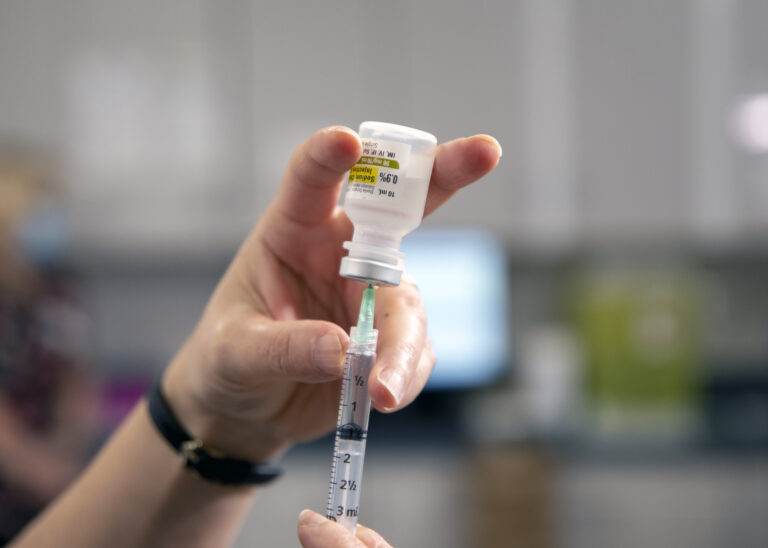
The Buffalo River Dene Nation reported 47 active cases of COVID-19 in the community and counting as of 3 p.m. on Tuesday as residents who were evacuated due to fires near Dillon return home from Lloydminster.
That’s up from 35 active cases on Monday when the First Nation reported an increase of 30 active cases since July 15.
“We’ve had an increased number of cases within the far northwest communities. Most of the cases that have been reported are within the Buffalo River Dene Nation,” Northern Inter-Tribal Health Agency (NITHA) medical health officer Nnamdi Ndubuka told the Prince Albert Daily Herald.
“The increase is related to the displacement and evacuation due to the current forest fires — that was the main risk factor. Travel outside of the province was also identified as a risk factor for increased transmission.”
Mass testing was offered in the community on July 16 due to climbing case numbers. At that time the First Nation reported 37 per cent of residents had received their first dose of the vaccine and 22 per cent were fully vaccinated.
Residents are being encouraged to continue following protocols such as wearing face masks, washing hands frequently, and social distancing. Results of rapid testing efforts in the community are still in progress and residents are asked to be patient for their results to come back.
The province reported 14 new cases of COVID-19 in the far northwest on Tuesday. Three new cases are reported in the far northeast and two in the northwest.
The English River First Nation (ERFN) emergency management team reported no cases of COVID-19 in its communities or in Patuanak on Tuesday — although a few people are still in isolation “for a few more days.”
“Prayers for the community of Buffalo River Dene Nation where they now have 35 active cases of COVID-19 on top of having been evacuated due to fire,” the ERFN’s pandemic planning committee said in a statement.
Canadian Forces Rangers were deployed on July 9 to help with a “challenging” COVID-19 outbreak at the Hatchet Lake First Nation near the hamlet of Wollatson Lake in the northeast.
“Rangers will be activated in the area to help community members limit the spread of the virus,” Minister of National Defence Harjit Sajjan said.
The Saskatchewan Health Authority said it has “activated surge capacity” and additional staff have been mobilized from both NITHA and Indigenous Services Canada to deal with the Hatchet Lake outbreak.
Ndubuka said the outbreak in Hatchet Lake now contained, the number of new cases have decreased “quite significantly” and people “continue to recover as we speak.”
“We’re still working with the health team there to increase the vaccination and they have done an amazing job in terms of vaccination efforts and also case isolation,” Ndubuka said.
Although Saskatchewan has rescinded all public health orders — including the province wide mandatory masking requirement — after ending its state of emergency on July 11, several northern communities still require masks in public spaces.
Both NITHA and the Athabasca Basin Health Authority (ABHA) are asking northerners to continue following pandemic protocols and to get vaccinated.
Taiwo Olubanwo, executive director of primary health care for the ABHA, encouraged northerners to continue to follow COVID-19 guidelines in a memo July 9.
He said northerners need to take precautions to avoid spread of the disease until a higher vaccination rate is reached.
“Soon, most of the COVID-19 related restrictions will be lifted in Saskatchewan. This is because the number of individuals who received the COVID-19 vaccine is encouraging especially in the southern part of Saskatchewan,” Olubanwo said.
“This fact is not so in the northern part of Saskatchewan.”
Ndubuka agreed. He said the situation now at Buffalo River Dene Nation is a case in point.
“I think the main lesson is that individuals should get the vaccine and also continue to practice public health measures that will make the community safe,” Ndubuka said.
“We also want individuals who have symptoms that may or may not suggest COVID-19 to please stay away from attending any gathering or going to work — to prevent further risk of transmission.”
The Lac La Ronge Indian Band (LLRIB) in the northeast also continues to observe COVID-19 safety protocols in the workplace. Mandatory masking and physical distancing is required within all LLRIB businesses and facilities until further notice.
“Due to lower vaccination rates in our communities, it has been strongly recommended by our medical health officer with NITHA that First Nations in Saskatchewan consider a more cautious approach to re-opening compared to the rest of Saskatchewan,” the LLRIB said in a media release.
“Immunization continues to be the most important measure that can be taken to stop the spread of COVID-19 in First Nations communities.”
